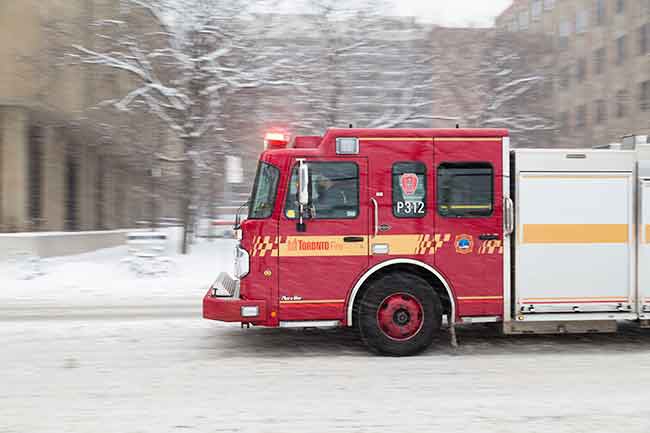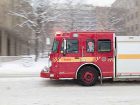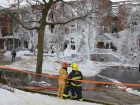
Features
Training
Trainer’s Corner: December 2015
I’m an old-school gearhead and I take pride in my tools. My standard wrenches are hung in precise order from 1/4 inch up to 1 1/4.
December 7, 2015
By Ed Brouwer
 Icy Winter storms and frigid conditions can severely tax both firefighters and equipment
Icy Winter storms and frigid conditions can severely tax both firefighters and equipmentHowever, inside one drawer of my toolbox you’ll find a couple of adjustable wrenches. These, admittedly, do come in handy sometimes.
The older I get, the more I see adjustability as a good thing. Adjustability defined is to move or change (something) so as to be in a more effective arrangement or desired condition; or to change so as to be suitable to or conform with something else.
In other words, being able to adapt. Nowhere is adjustablity as a trait more necessary than in fire fighting, especially cold-weather fire fighting.
Welcome to Searing Heat and Numbing Ice; no, not a new reality show, just the winter fire ground anywhere in Canada. Cold weather makes one of our nation’s most dangerous professions even more hazardous. I love fire fighting, but fire-ground operations in below freezing weather are not fun.
Not only do the most serious fires occur during the winter months, the cold and wet days add special concerns to the fire ground. Icy, snow-packed roads can hinder access and slow down response times. Fire fighting operations must adapt to our local winter conditions.
Firefighter safety does not begin once on scene; it must become a primary consideration for incident command (IC) the moment the bay doors open.
So just how adaptable (adjustable) is your department? Consider the following questions:
- What winterizing needs to take place for your water-based extinguishers?
- Are your pumps kept wet or dry during winter conditions?
- What can you do to unthaw a frozen hose coupling?
- What should be done with charged lines and nozzles when not operating?
- What is the procedure if a hydrant is found frozen or inaccessible?
- What driving SOGs exist for operations in winter conditions?
- ICs must keep adaptability in mind as they make critical decisions:
- Are tactical positions attainable, or are they blocked by snow banks?
- Can personnel access all sides of the building?
- Has the snow hidden any hazards?
- Are fire hydrants visible and accessible?
The following is a collection of suggestions I have come across (not sure to whom credit belongs) regarding cold-weather fire-ground operations. Take what works for your department.
Make sure that tire chains or other traction devices are available for all first-in units. If you have tire chains, make sure everyone is trained to install the chains and on proper driving techniques with chains. Those with insta-chains make sure they engage and disengage properly. You should also check your tandem axle differential lock-ups, if you have them.
Carry a supply of salt, sand or oil-dry to enhance footing and reduce the possibility of falls.
If charged hoselines are going into a long standby mode, partially open the control valves to allow water to flow and prevent freezing.
During heavy snowfalls, trucks may be forced to operate at a greater distance from the fire building. Add extra lengths of attack line to preconnects to compensate for that additional reach requirement.
Ensure that extra turnout gear is available, especially gloves. It’s a good idea for firefighters to wear layered clothing.
Bunker boots coupled with winter roof conditions can quickly add up to an accident. Some soles harden in cold weather, others are worn smooth (and really should be replaced); both cases can prevent firefighters from having good traction in the winter, especially on icy roofs. Removable traction grips are available to fit bunker boots.
Fire hydrants near roadways can quickly become covered with plowed snow. Routinely check on the accessiblity of hydrants and clear any snow from around them.
Small, handheld propane torches can help free frozen hydrant caps or hose couplings. A spray bottle full of antifreeze can also help free icy caps or couplings. Try spraying antifreeze on port cap threads ahead of time to prevent them from freezing.
Vehicles that are in marginally good mechanical condition during other seasons are almost guaranteed to fail when the weather turns cold. Severe cold will significantly reduce battery capacity, so check all batteries as part of an overal winter maintenance.
Some departments have found some success with plug-in battery trickle chargers and engine pre-heaters to help during bitter-cold start-and-go scenarios, when heavy engine wear and poor performance can be a problem.
Finally, don’t forget to review the procedures for dealing with hypothermia and frostbite. This knowledge is not just for the public, but also for your fellow firefighters.
Remember that winter storms and frigid conditions can severely tax both your firefighters and your equipment. Please remind your members that whether working in desert heat or Arctic cold, firefighter safety is of paramount importance to you and your department.
Under pressure, you don’t rise to the occasion, you sink to the level of your training. That’s why we in the Canadian fire services train so hard.
And to you, the training officer, as this year comes to an end and a new one begins I want to personally thank you for your dedication to excellence in the Canadian fire service. Thank you for training as if lives depend on it!
Until next time – stay safe out there.
Ed Brouwer is the chief instructor for Canwest Fire in Osoyoos, B.C., and training officer for Greenwood Fire and Rescue. Ed has written Trainer’s Corner for 14 of his 27 years in the fire service. Contact Ed at ebrouwer@canwestfire.org
Print this page

